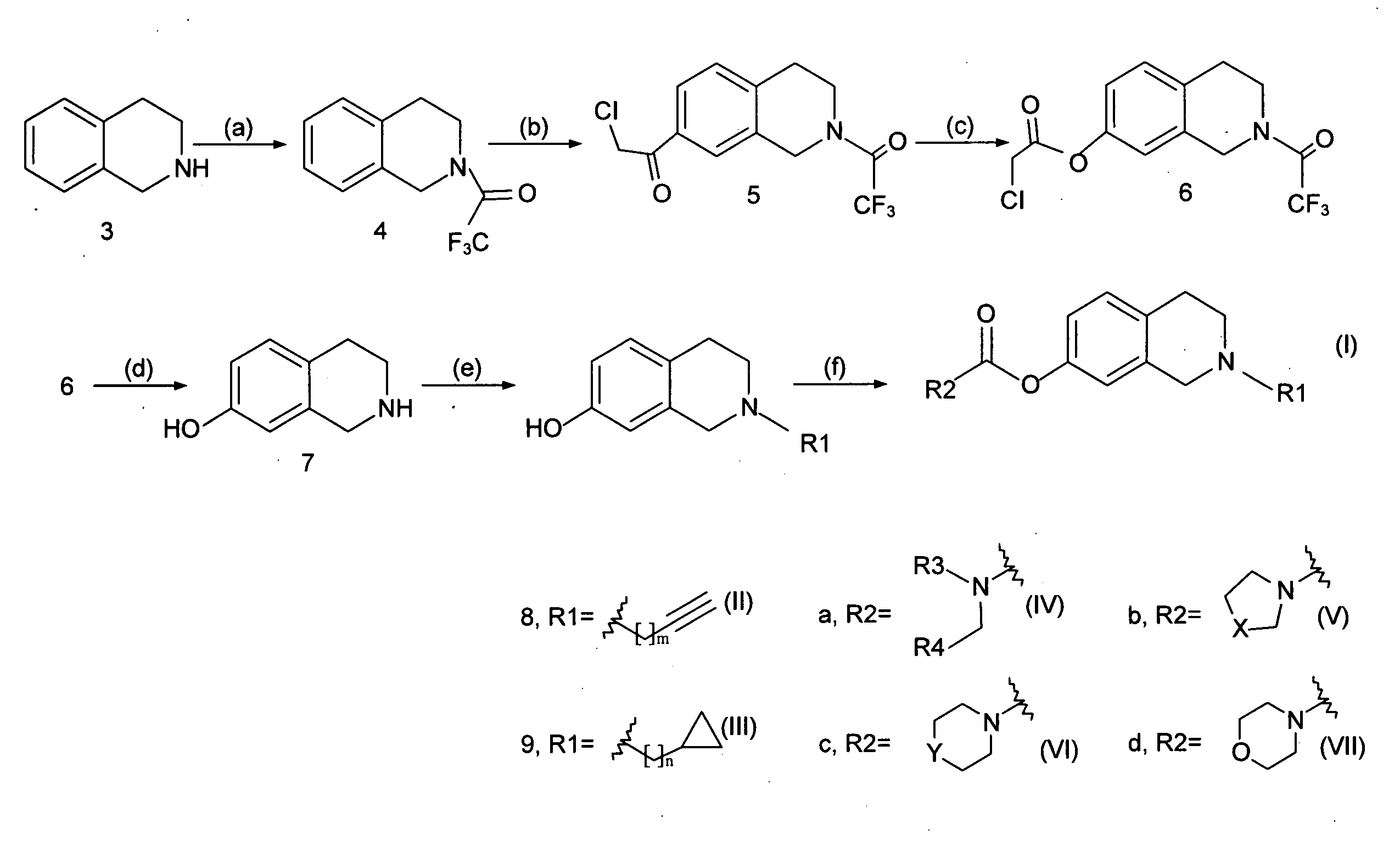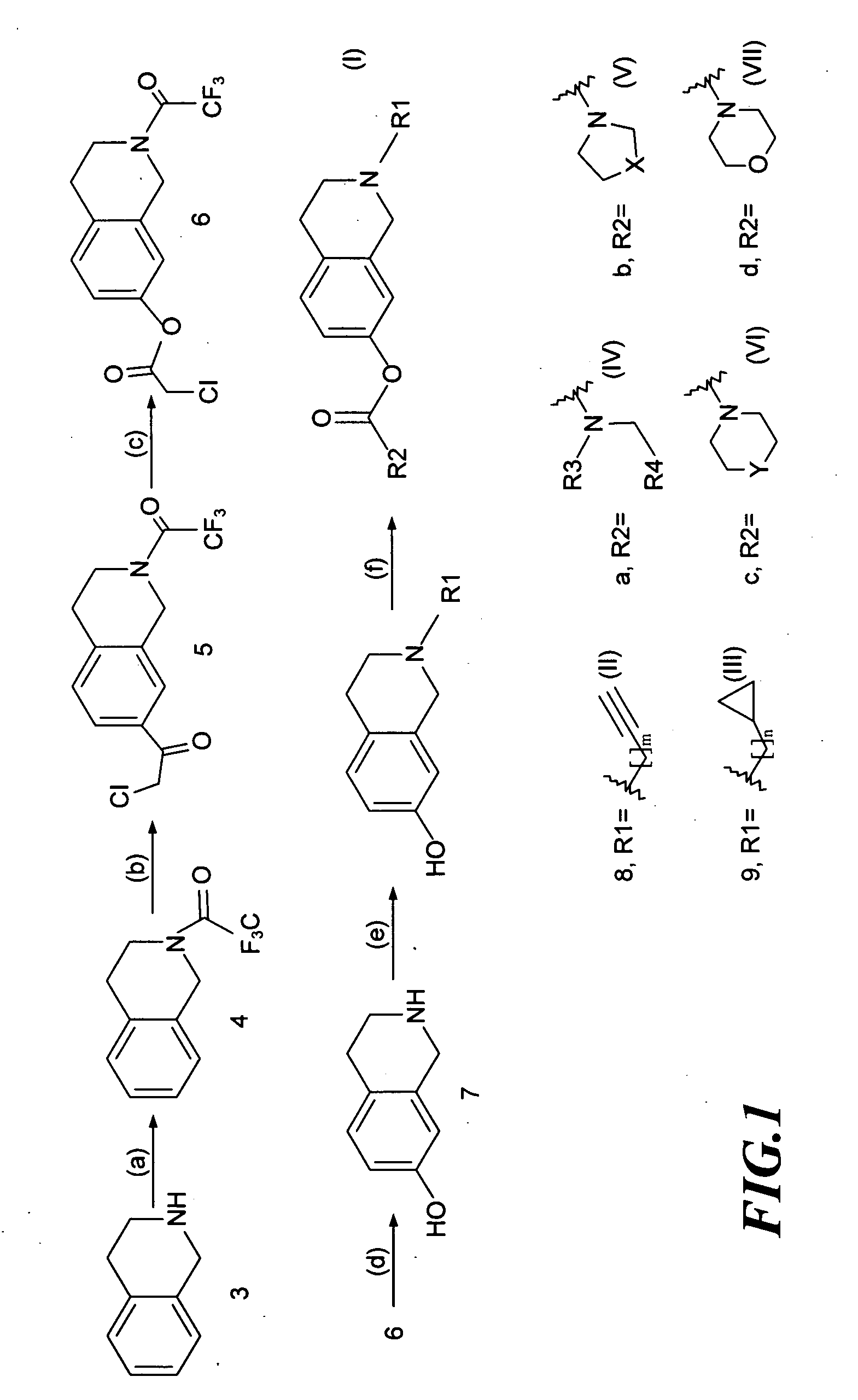1,2,3,4-Tetrahydroisoquinoline Derivatives, Preparation Process therefor and Pharmaceutical Composition Containing the Same
a technology of tetrahydroisoquinoline and derivatives, applied in the field of new drugs, can solve the problems of inability to understand conversation content, inability to understand language and emotion, and gradual loss of memory and emotion
- Summary
- Abstract
- Description
- Claims
- Application Information
AI Technical Summary
Benefits of technology
Problems solved by technology
Method used
Image
Examples
example 1
The Synthesis of 7-carbamoyl-1,2,3,4-tetrahydroisoquinoline Derivatives 11a-d and 12a-d
[0028]As shown in FIG. 1, the invention used 1,2,3,4-tetrahydroisoquinoline as the reaction starting material (3) (available from US Sigma-Aldrich Co.), and carried out chemical synthetic reactions to modify various functional groups to produce novel derivatives with structure of formula (I).
[0029]The chemical synthesis steps used to prepare said novel 1,2,3,4-tetrahydroisoquinoline derivatives will be described below:
Step (a): N-Trifluoroacetyl-1,2,3,4-tetrahydroisoquinoline (4)
[0030]To an ice-cooled solution of trifluoroacetic anhydride (9 ml) in CH2Cl2 (32.4 ml) was added dropwise a solution of 1,2,3,4-tetrahydroisoquinoline (8 ml, 60 mmol) in CH2Cl2 and stirred under ice-cooling for 3.5 h. A solution of KOH (4.74 g, 85 mmol) in water (72 ml) was then added, and the reaction mixture was stirred for further 2 hours at room temperature. The resulting mixture was extracted with CH2Cl2 and the org...
example 2
Analysis of the Inhibiting Ability of 1,2,3,4-tetrahydroisoquinoline Derivatives on γ-secretase
[0051]Since said derivatives had similar chemical structure to selegiline and rasagiline, in this example, assays were carried out to determine whether said derivatives exhibited the activity of inhibiting γ-secretase, and further the ability of modulating proteolytic process of amyloid precursor protein (APP). In this example, a quantitative cell-based assay described in reference (2) and (3) was employed to measure the activity of-γ-secretase in T-20 cell line.
[0052]To measure the activity of γ-secretase, it was essential to produce first a stably transfected cell T-20 in this example according to the following steps:
1. Construction of C99-Gal4-VP16 / TO (C99-GV / TO) Plasmid
[0053]A construction method had been disclosed in reference (2). Briefly described below, since amyloid precursor protein (APP) could be cleavaged with α-secretase or β-secretase to form fragment C83 (C terminal of amyl...
example 3
Cytotoxicity Assay of 1,2,3,4-tetrahydroisoquinoline Derivatives
[0062]In this example, animal cell was used to assay whether 1,2,3,4-tetrahydroisoquinoline derivatives exhibited cytotoxicity against cells. Animal cells used here included, but not limited to, Human embryonic kidney cells (HEK293) and other animal cells that were suitable for testing cytotoxicity.
[0063]In a preferred embodiment, said animal cell was human embryonic kidney cells (HEK293), which was used to test whether 1,2,3,4-tetrahydroisoquinoline derivatives exhibited cytotoxicity to said cell.
1. Cell Culture
[0064]Human embryonic kidney cells (HEK293) were maintained in Dulbecco's modified Eagle's medium (DMEM) supplemented with 10% fetal bovine serum (FBS) and each of 0.1 mg / ml of penicillin and streptomycin. HEK293 cells were purchased from Invitrogen. T-20 was the subclonal cell line of HEK293 and γ-30 was one disclosed in reference (3). Cells were incubated in a humidified incubator at 37° C. in 5% CO2.
2. Cell V...
PUM
| Property | Measurement | Unit |
|---|---|---|
| Structure | aaaaa | aaaaa |
Abstract
Description
Claims
Application Information
 Login to View More
Login to View More - R&D
- Intellectual Property
- Life Sciences
- Materials
- Tech Scout
- Unparalleled Data Quality
- Higher Quality Content
- 60% Fewer Hallucinations
Browse by: Latest US Patents, China's latest patents, Technical Efficacy Thesaurus, Application Domain, Technology Topic, Popular Technical Reports.
© 2025 PatSnap. All rights reserved.Legal|Privacy policy|Modern Slavery Act Transparency Statement|Sitemap|About US| Contact US: help@patsnap.com



